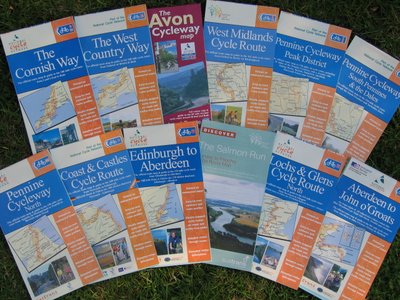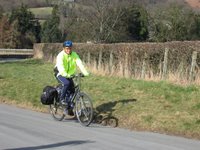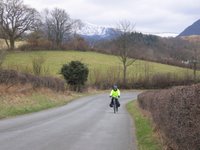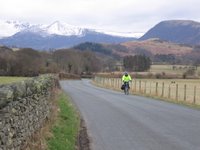I have been experimenting with all sorts of different meals and snacks, trying to target foods that are high in carbohydrates, particularly those that are starchy, rather than sugar based, for sustained energy.
I have read that endurance cyclists need to be consuming up to 700g of carbohydrates on a daily basis, in order to replenish the glycogen stores that are converted into energy. This is a phenomenal amount of food and when taking into consideration the fact that the cyclist is always on the move, it becomes a real problem in finding the time to eat.
There are other practical issues at stake, insofar that I have chosen to camp which involves having to carry a lot of my food to last for several days. The food has to be transportable and it needs to be fresh. It also has to be relatively easy to prepare.
I have been eating different foods as part of my training regime, trying to gauge the relative benefits, both during and after exercise. After much deliberation, I have finalised the following list of food and drink that I will be using:
Scott’s Porage Oats (Old Fashioned)
Marvel Dried Skimmed Milk
Drytech Real Expedition Meals
Quaker Oat Bars (Original)
Bananas
High5 Energy Source (4:1)
SIS Rego Recovery
Horlicks Light Malt
WaterOtherThe list can be detailed as follows:
Scott’s Porage Oats (Old Fashioned)
Breakfast was a choice of either porridge or muesli. I used to eat muesli in my backpacking days and it is certainly easier to prepare in a tent as there is no cooking involved. But porridge is an excellent staple diet and is better for sustained energy. It will provide me with a very good start to the day and there is the option of eating further portions after that. The cycling day will be spread over 12 hours, so there is always the need for more porridge.
Nutritional values: 11% protein, 60% carbohydrate (of which sugars 1.1%) and only 8% fat.
Quantities: 1kg (Scott’s Porridge is sold more or less everywhere, so supplies can be readily replenished).
Marvel Dried Skimmed MilkDried skimmed milk is used solely for mixing with the porridge. I will mix it all in before I set off from home and will have to purchase more when I’m due to replenish the porridge.
Nutritional values: 36.1% protein, 52.9% carbohydrate and less than 1% fat.
Quantities: 200g (I will need to purchase a small tin when I replenish the porridge).
Drytech Real Expedition MealsI discovered these expedition meals last year, sold at George Fishers mountaineering shop in Keswick. I used them for last years ride and I cannot fault them in any way. They provide a wholesome evening meal and have the important benefit of being freeze dried and therefore are light to carry. They are very easy to prepare, as you simply add boiling water to the bag. There is a choice of several different menus, but my favourite is pasta vegetarian.
Nutritional values: 11% protein, 65% carbohydrate and only 2% fat.
Quantities: Each bag weighs 100g, so I will start with a maximum supply of 14 meals. I am hoping that another outdoor shop will sell them en route, so that I can bolster my supply. If not, I will have to see what else is on offer!
Quaker Oat Bars (Original)
These are my favourite cereal bars, as they contain less sugar than most other bars and are therefore better for sustained energy. I will be looking to eat these quite regularly and will be a slave to finding retail outlets that sell them.
Nutritional values: 7.2% protein, 64.4% carbohydrate (of which sugars 16.7%) and only 9.4% fat.
Quantities: I will aim to set off with about 3 boxes (15 bars), but they will be consumed rapidly).
Bananas Bananas are the best choice of regular snacks between meals. They are the superman of all exercise foods as they provide a great boost of energy and are naturally very healthy too.
Nutritional values: Bananas are made up primarily of water and about 23% carbohydrate, with absolutely no fat.
Quantities: Bananas do not travel well, unfortunately. So it will be a case of buying ripe ones at every opportunity, consuming them more or less immediately.
High5 Energy Source (4:1)
Energy Source 4:1 is a specialist sports drink made in powdered form, to which you simply add water. It is an advanced fuel for use
during exercise and contains 4 parts carbohydrate to 1 part protein. This will be vital for keeping up my energy reserves, as it is quickly absorbed by the body and will help to stave off the effects of dehydration.
Nutritional values: 20% protein, 77% carbohydrate (of which sugars 10%) and no fat.
Quantities: 1.3kg. It is recommended to use 75g (750ml) per hour during intense activity, but in reality I’m sure that I will use much less. Most food shops tend not to sell specialist sports drinks of this nature, so I will be reliant on outdoor shops for replenishment. If I cannot restock, then I will buy Lucozade Sport drinks that are an adequate alternative, although I would have to drink these more or less immediately due to the weight.
SIS Rego RecoveryLike Energy Source, Rego Recovery is a specialist sports drink made in powdered form, but is designed for use
after exercise. It provides rapidly absorbed protein and carbohydrate, together with vitamins and minerals, to help rebuild and repair muscles.
Nutritional values: 26% protein, 59% carbohydrate (of which sugars 14%) and only 1.3% fat.
Quantities: 500g. It is recommended to use 100g (1ltr), which I will aim to drink immediately before camp. Obviously with only 5 days supply, I will need to be on the lookout to replenish supplies, but if that is not possible then I will just have to do without.
Horlicks Light MaltHorlicks is my only chance of a hot beverage as I do not drink tea or coffee. It has excellent nutritional values and will help to induce a restful sleep, which is not guaranteed when camping. The Light version is simple to make, as you simply add hot water.
Nutritional values: 14.8% protein, 70.3% carbohydrate (of which sugars 41.2%) and only 3.8% fat.
Quantities: 500g. I will aim to use less than the recommended serving of 32g per cup, drinking only 1 cup per day and would hope to make this last for the whole trip.
WaterWater is the one thing that I cannot do without. It is vital. It is the one ingredient that I will need to replenish on a constant basis, which will mean having to be extremely resourceful. I will be looking to buy it in bottle form, or will need to beg for it at houses, farms etc. The need to keep hydrated cannot be underestimated. I will also need water to add to my sports drinks, Horlicks and for adding to my evening meal and porridge in the mornings.
Quantities: I will be carrying 3 x 700ml bottles that attach to the frame of the bike and will be looking to top up at every opportunity. I will also be carrying a further 1 x 750ml bottle to use for the sports drinks only. Each powdered drink will be made up and consumed immediately and the empty bottle stowed away in the panniers.
OtherThere will be times when I cannot find the right shops to replenish my supplies, or that I will choose to vary my diet. Quick-cook pasta would be a good alternative to the Drytech meals, perhaps adding dried onions and primula cheese. Wholemeal bread rolls are rich in carbohydrates, as too are oat and rice cakes. Brazil nuts and dates are also a good choice, although nuts are best left until the end of the day - the high fat content will slow digestion during exercise. A small carton of orange juice is an instant source of carbohydrates and dried fruit has all the sustained energy benefits of fruit without carrying the extra weight of the water content. Lastly, I have read that rice pudding is an excellent end of day food, with plenty of carbohydrates as well as protein to help with muscle repair for the next day.
I certainly won't be relying on chocolate bars, which serve only to provide a surge of energy, followed by a state of exhaustion caused by the depletion of glycogen in the muscles.









